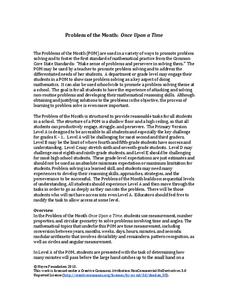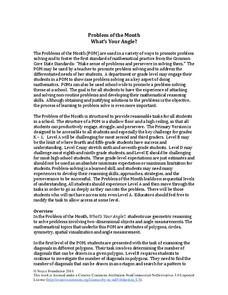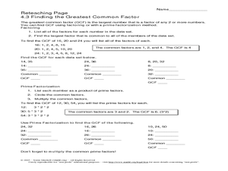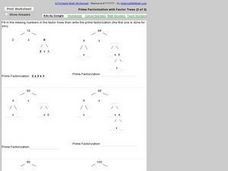EngageNY
Least Common Multiple and Greatest Common Factor
Find the common denominator between prime factors, factor trees, and the distributive property. Scholars learn to find the least common multiple and greatest common factor of pairs of numbers. They rotate through stations to connect...
EngageNY
Divisibility Tests for 3 and 9
Who knew the sum of a number's digits gives such interesting information? The 18th installment of a 21-part module has scholars investigate division by three and nine. After looking at several examples, they develop divisibility tests...
EngageNY
Even and Odd Numbers
Even or not, here I come. Groups investigate the parity of products and sums of whole numbers in the 17th lesson in a series of 21. Using dots to represent numbers, they develop a pattern for the products of two even numbers; two odd...
Noyce Foundation
Once Upon a Time
Examine the relationship between time and geometry. A series of five lessons provides a grade-appropriate problem from elementary through high school. Each problem asks learners to compare the movement of the hands on a clock to an angle...
Noyce Foundation
What's Your Angle?
Math can be a work of art! Reach your artistic pupils as they explore angle measures. A creative set of five problems of varying levels has young learners study interior and exterior angle measures of polygons. The introductory levels...
West Contra Costa Unified School District
Lowest Common Multiple through the Grades
The LCM will be your new BFF. Learners review least common multiple and least common denominator applications, mostly on fractions, from middle school. Scholars then see how the LCM can be applied to various types of problems from...
Mathed Up!
Factors, Multiples, and Primes
Reinforce the concept of factors, multiples, and prime numbers with a 16-problem practice worksheet. Eight pages offer a variety of problem solving opportunities with clear objectives and tips for successful completion.
Willow Tree
Factoring
Build an understanding of factors and use it to write the prime factorization of numbers. After exploring key vocabulary, learners create prime factorization for given numbers. They then use the prime factorizations to determine the...
Los Angeles County Office of Education
Assessment For The California Mathematics Standards Grade 6
Test your scholars' knowledge of a multitude of concepts with an assessment aligned to the California math standards. Using the exam, class members show what they know about the four operations, positive and negative numbers, statistics...
MLC
Fractions Packet
Your fifth graders will appreciate the simple, direct explanations, examples, and practice exercises in this well-organized unit on fractions. Beginning with an introduction to fractions, the packet flows smoothly through the fraction...
Scholastic
Study Jams! Prime Factorization
Deepen the number sense of young mathematicians by exploring the process of prime factorization. Follow along with this step-by-step presentation that explains how factor trees are used to break a composite number down into its prime...
Scholastic
Study Jams! Distributive Property
The distributive property is a foundational skill taught two ways in this interactive web page. Your young mathematicians can practice their order of operations by solving distributive problems working from inside out. They then move on...
Scholastic
Study Jams! Greatest Common Factor
When one method isn't enough to teach GCF, try two! This interactive webpage introduces factors and the prime factor tree to find the greatest common factor of two numbers. After the lesson, have learners click to try the two examples...
Illustrative Mathematics
Adding Multiples
Mathematicians practice communicating why the sum of two multiples of a number results in another multiple of that number. Encourage learners to construct a viable argument by applying the distributive property or by drawing a diagram....
Illustrative Mathematics
Bake Sale
Put math into action with the real-life scenario of a bake sale. The participants at this bake sale are ready to divide their fresh-baked cookies into bags. It is up to your number crunchers to help decide how many cookies should go in...
Illustrative Mathematics
Multiples and Common Multiples
Learners are asked to find multiples and common multiples of two numbers. They must take their findings and find a pattern between the numbers and explain their reasoning. Use this resource with The Florist Shop activity in this series...
Illustrative Mathematics
The Florist Shop
A real-world approach to common multiples asks learners to find different groups of flowers based on their multiples. Useable as a class activity or independent exercise, they will have to organize their thoughts to explain the totals of...
Illustrative Mathematics
Factors and Common Factors
This is an exercise in finding the greatest common factor of two whole numbers. Use in direct instruction or as part of your guided practice. Make up additional problems for home work. It also can be used as a mini-assessment or test...
Curated OER
Atomic Candy
Mmmmm! Radioactive "candium!" Nuclear physics or chemistry classes use M&M'S® to demonstrate the process of radioactive decay. Individuals pour out a bag of candies and record the number that fall M-side-up to represent the number of...
Curated OER
Factors and Multiples
Middle schoolers use the factor box process for identifying the greatest common factor and the least common multiple for 10 pairs of numbers. This single-page instructional activity is simple, and makes a useful assignment for practicing...
Norm Mitchell
Reteaching Page 4.3 Finding the Greatest Common Factor
A bit of instruction on how to find the greatest common factor opens the activity. Leanrers are then given three practice pairs of numbers. Then the assignment goes on to describe prime factorization, and also provides three more...
Mrs. Glosser's Math Goodies
Number Theory Worksheet 3
A nine-row data table has novice number crunchers fill in columns for the greatest common factor, least common multiple, product of the two, and product of numbers. The pairs of numbers to work with are all single- and double-digit...
Curated OER
Prime Factorization with Factor Trees (1 of 2)
Six numbers (12, 32, 50,48,36, and 75) are given to learners to craft factor trees with. The first one is completed as an example in this first of two similar online worksheets. Note that where factorization is an foundational step in...
Helping with Math
Prime Factorization with Factor Trees (2 of 2)
The publisher has tagged this resource as designed to meet CCSS.Math,Content.6.NS.4, but it really is only the first step in the process of determining least common multiples and greatest common factors. Six numbers are given for...























